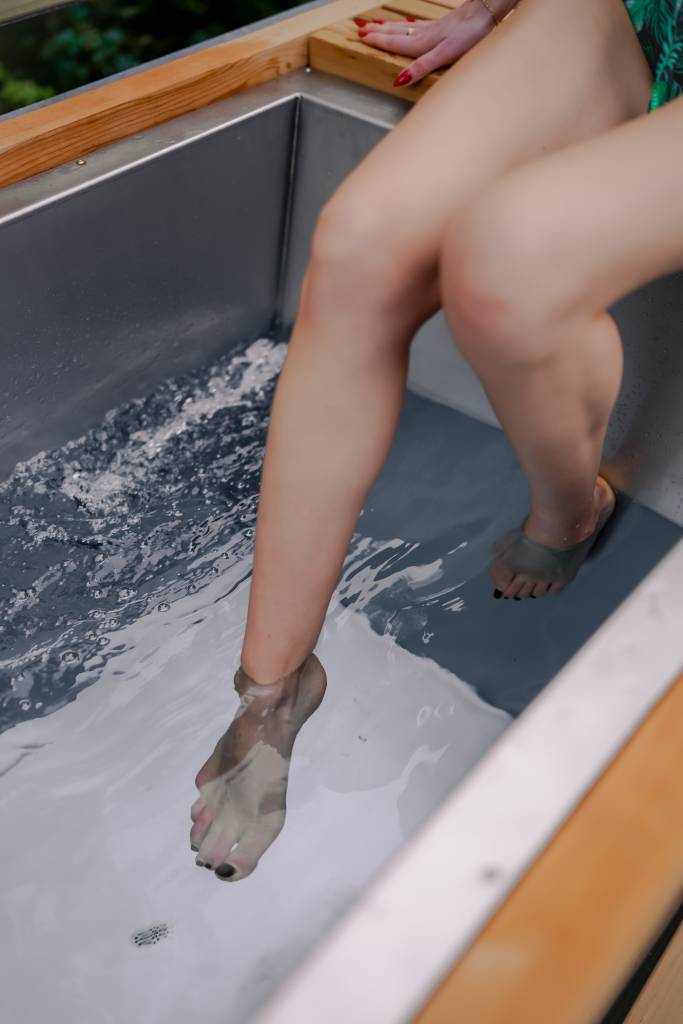We likely owe Dutch adventure athlete Wim Hof, known as “The Iceman,” for transforming icy plunges from a New Year’s tradition into a popular health and fitness trend.
Wim and other cold-water enthusiasts praise the benefits, claiming that cold showers, baths, and swims can accelerate recovery, alleviate pain, prevent colds, and improve mood. But is it time for you to try it? That depends on your health and personal goals. Let’s explore the science behind it and the available cold therapy options.
What is cryotherapy?
“Cryo”, derived from the Greek word krýos meaning “icy cold,” refers to various methods of cooling the body to promote health and recovery. It’s also known as “cold therapy,” with several common techniques:
Ice application: Applying ice or a cold pack to a specific area of the body.
Cold showers: Standing under a stream of cold water, turning off the hot completely.
Cold water immersion (CWI): Submerging the body in water at 60°F/15°C or colder, often referred to as a “cold plunge.”
Whole-body cryotherapy (WBC): Exposing the entire body to freezing air in a specialized chamber, without the use of water.

The health benefits of ice baths
So, does cryotherapy live up to the hype? In most cases, not entirely. A study published in Nature Scientific Reports asked participants to practice the Wim Hof method — combining cold exposure, breathing exercises, and meditation—for 15 days. The results showed no significant improvements in blood pressure, heart rate, heart function, or mood. While some studies suggest potential benefits of cryotherapy, much of the research lacks the strength to confidently back many claims.
Additionally, the effort required to achieve even modest results may not justify the practice for some. That said, as long as cryotherapy is done safely, there’s no harm in enjoying the experience or feeling that it helps boost your resilience.
Here’s what the science says about different cryotherapy methods and their claims:
Ice packs or cold plunges and athletic recovery
For many years, icing was a go-to treatment for injury recovery, serving as the “I” in the RICE (Rest, Ice, Compression, Elevation) formula. However, the science and application of icing have evolved over the past two decades, explains Andrew Jagim, Ph.D., a sports medicine specialist at the Mayo Clinic.
Jagim now recommends a more tailored approach:
• Apply ice immediately after an acute injury to help reduce swelling and pain.
• Limit or avoid icing after the first few days, as prolonged cold exposure may hinder healing and slow recovery.
Cold therapy can also ease pain and soreness following intense workouts or during high-demand competition periods. However, when used frequently over time, it may negatively impact performance.
“If an athlete is facing an intense two-week practice schedule or a three-day tournament and experiencing significant soreness, ice baths may help post-workout or throughout the day,” Jagim advises. “But using them daily for an entire season or training cycle could interfere with long-term strength and muscle growth adaptations.”

Cold showers and immunity
It’s said that Thomas Jefferson began each day by submerging his feet in cold water, believing the habit helped ward off the common cold, as noted in a letter he wrote to a physician.
Modern cold-water enthusiasts make similar claims, suggesting that cold immersion and other brief stressors, or “micro stressors,” may help train the immune system to handle more significant challenges, such as injuries or infections.
One study tested this theory by assigning 3,018 office workers to different intervention groups. While some workers made no changes to their morning routines, others ended their showers with 30-, 60-, or 90-second blasts of cold water. After 60 days, those who took cold showers reported 29% fewer sick days and increased energy.
Although the results are promising, the reason for fewer sick days remains unclear since the study didn’t track immune markers or physiological changes. More research is needed to confirm any immune-boosting benefits. In the meantime, if you enjoy short cold showers, there’s no harm in continuing the practice.
Cryotherapy and pain
Icing works by restricting blood flow, slowing nerve signaling, and reducing swelling—all of which help to ease pain.
Applying ice immediately after an injury can provide short-term relief and may also help with temporary discomfort from headaches or tendonitis flare-ups. However, for longer-term injuries like muscle or joint strains, prolonged icing may actually slow the healing process by repeatedly reducing blood flow and interfering with the signaling mechanisms that promote tissue repair.
In these cases, heat therapy may be more effective. Heat improves circulation, promotes healing, supports exercise recovery, and can even benefit cardiovascular health.
Ice baths and metabolic health
Laboratory research on rodents suggests that habitual cold-water immersion may help alter or reduce fat tissue. These changes could, in theory, lead to other health benefits, such as lower cholesterol and improved blood sugar levels. However, it’s important to note that just because rodents showed slight fat loss doesn’t guarantee the same outcome in humans, especially since human studies on this topic are lacking.

Mental benefits of ice baths
Although research on cold water therapy is still in its early stages, it may help reduce fatigue and improve mood, potentially by triggering the release of endorphins and noradrenaline in the brain.
One small study of 33 adults found that a five-minute cold water immersion boosted alertness and attentiveness while reducing perceived distress and anxiety. In another study, young adults who submerged a hand in cold water for three minutes felt less sleepy—despite being woken in the middle of the night—and performed math problems faster than those who had their hand in warm water.
However, these studies are small and involve scenarios that may not be practical for everyday life—unless you’re solving math problems at 2 a.m. Larger, randomized controlled trials are needed to determine whether these effects could apply to more typical, routine situations.
Are ice baths worth it?
Dr. Jagim likens the decision to try cryotherapy to cooking dinner: exercise, a balanced diet, sleep, and stress management are the essential ingredients—the veggies, whole grains, and meat of the meal—while cold plunges and other cryotherapies are more like a garnish.
Focus on the main course before worrying about the garnish.
– Andrew Jagim, Ph.D.
If you choose to try cryotherapy, Dr. Jagim suggests experimenting at home with someone nearby, starting in your shower or bathtub before moving to open water.
Begin with short submersions of 30 seconds to a minute, and, if desired, gradually extend it to 5 to 10 minutes. Start with cold water, but avoid freezing temperatures at first.



